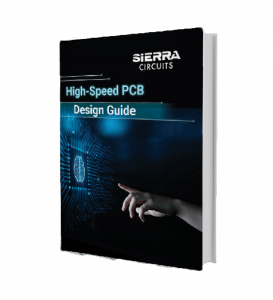High-Speed PCB Design Guide
The Sierra Circuits High-Speed Design Guide helps you design PCBs with signal frequencies from 50MHz to as high as 3GHz and beyond.
Complex electronics require increased component counts on ever-shrinking PCB designs. The result is high-density and high-frequency of circuit operation. This High-Speed PCB Design Guide will challenge your PCB design skills.
Download the guide to learn about:
- What leads to signal integrity issues
- Transmission lines and controlled impedance
- Selecting high-speed PCB materials
- High-speed layout guidelines
Considerations for designing for high-speed PCBs
To execute a successful design for a circuit board, one has to first determine if it is in fact a high-speed design. If it is a high-speed design, then the PCB designer would need to take special care during the design process; and we would call them high-speed design considerations – the main subject of this guide.
In most cases, based on their past experience, the design engineering team may determine the nature of the design.
In order to determine if the PCB requires high-speed design, we follow a two-step process:
First, the designer must state the values of one or more of the following parameters:
- The maximum frequency (Fm)content in the highest speed signals in the circuit.
- The fastest rise (or fall) time (Tr) of the digital signals in the circuit.
- The maximum data transfer rate (DTR) applicable for signals in the circuit.
Second, you need to determine the wavelength (λm) on the PCB of the electrical (electromagnetic to be precise) signals for a given frequency, in our case Fm.
Also inside this High-Speed PCB Design Guide:
- Factors that contribute to signal integrity degradation
- Errors to avoid when designing for controlled impedance
- High-speed PCB layout design guidelines, including:
- Component selection and placement
- High-speed routing strategy and signal proximity





